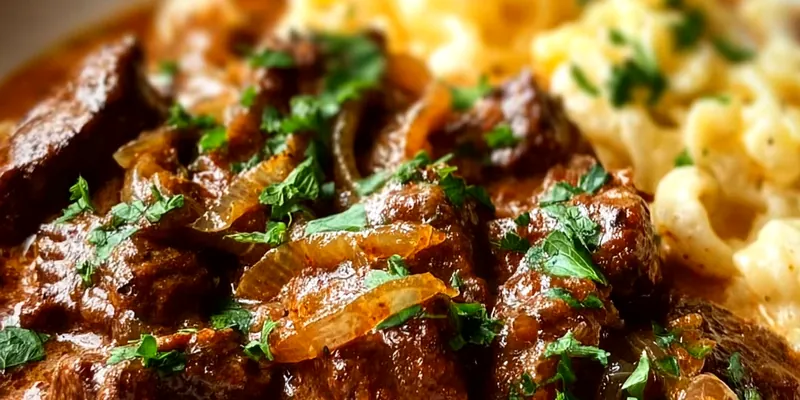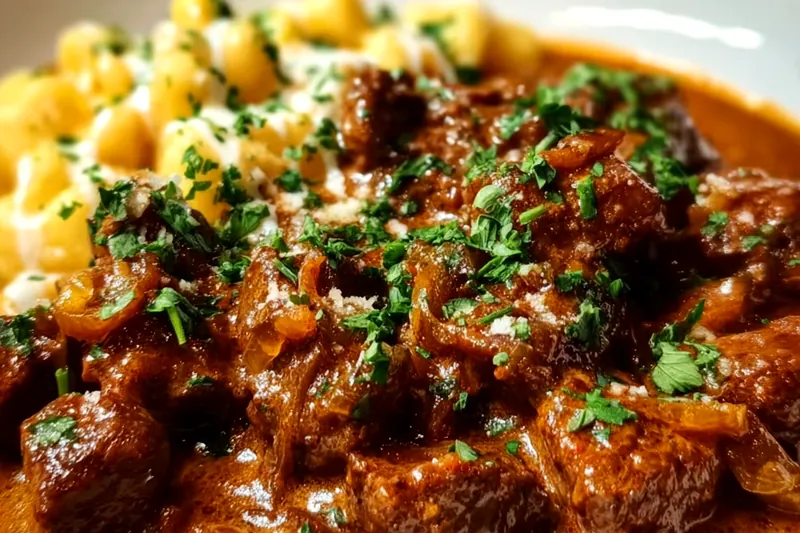Authentic German Goulash (Gulasch)
Traditional German goulash with tender beef, rich paprika sauce, and hearty vegetables. A warming comfort food perfect for cold days and family dinners.

The Heart of German Goulash
Authentic German goulash differs from its Hungarian cousin by incorporating a deeper, more complex flavor profile through slow braising and the careful balance of sweet and hot paprika. The key is allowing the onions to caramelize properly, creating a sweet foundation that complements the robust paprika.
The choice of beef cut is crucial for achieving the perfect texture. Chuck roast provides the ideal marbling that breaks down during the long cooking process, creating incredibly tender pieces that absorb the rich paprika sauce while maintaining their structure.
💡 Professional Tip
Toast the paprika briefly with the aromatics to bloom the flavors, but be careful not to burn it as this will create a bitter taste. Remove from heat if it starts to darken too quickly.
Frequently Asked Questions
Yes, German goulash actually improves in flavor when made a day ahead. Cool completely and refrigerate for up to 3 days. Reheat gently on the stovetop, adding a splash of broth if needed.
Chuck roast is ideal due to its marbling and connective tissue that breaks down during slow cooking. Beef short ribs or bottom round also work well for this recipe.
Yes, after browning the beef and sautéing the onions, transfer everything to a slow cooker. Cook on low for 6-7 hours or high for 3-4 hours, adding vegetables in the last hour.
Hungarian sweet paprika is preferred for authentic flavor, combined with a smaller amount of hot paprika for depth. Spanish smoked paprika can add an interesting variation.
Cook uncovered for the last 30 minutes to reduce the liquid. You can also mix a tablespoon of flour with cold water and stir it in during the last 10 minutes of cooking.
Traditional accompaniments include spaetzle, egg noodles, or crusty bread. Sour cream and fresh parsley are classic garnishes that balance the rich flavors.
Yes, goulash freezes well for up to 3 months. Note that potatoes may change texture slightly after freezing. Consider adding fresh potatoes when reheating if preferred.
Reduce or omit the hot paprika for a milder version, or add a pinch of cayenne pepper for extra heat. Taste and adjust gradually as paprika can vary in intensity.
Recipe Troubleshooting Guide
Tough Meat
Problem: Beef pieces remain tough after cooking time
Solution: Continue cooking longer at low heat. Tough cuts need time for connective tissue to break down. Check every 30 minutes and add liquid if needed.
Bitter Flavor
Problem: Goulash tastes bitter or burnt
Solution: This usually happens from burnt paprika. Cook paprika briefly over lower heat next time. Add a pinch of sugar to balance existing bitterness.
Watery Sauce
Problem: Sauce is too thin and watery
Prevention: Cook uncovered to reduce liquid, or create a slurry with flour and cold water. Stir in gradually until desired thickness is reached.
Lack of Flavor
Problem: Goulash tastes bland despite following recipe
Recovery: Increase seasoning gradually, add more paprika, or a splash of wine vinegar for brightness. Season in layers throughout cooking.
Vegetables Overcooked
Problem: Potatoes and peppers become mushy
Prevention: Add vegetables later in cooking process. Potatoes need 30-40 minutes, peppers need only 20-25 minutes to maintain texture.
Flavor Balance Issues
Too Sweet: Add more hot paprika or a splash of vinegar
Too Salty: Add diced tomatoes or a touch of sugar to balance
Bland: Increase paprika, add bay leaves, or finish with fresh herbs

Selecting Quality Ingredients
The foundation of exceptional German goulash lies in choosing well-marbled beef chuck roast, which provides the perfect balance of meat and fat for slow braising. The connective tissues break down during cooking, creating incredibly tender, flavorful pieces that absorb the rich paprika sauce.
Hungarian paprika is essential for authentic flavor - its sweet, complex taste is irreplaceable in traditional goulash. Quality paprika should have a vibrant red color and fresh, aromatic scent. Using both sweet and hot varieties creates the perfect flavor depth.
Essential Ingredient Notes
- Beef Selection: Choose chuck roast with good marbling throughout. The fat and connective tissue are essential for creating tender, flavorful meat during the long braising process.
- Paprika Quality: Invest in high-quality Hungarian paprika for the most authentic flavor. Store in a cool, dark place and replace annually for best results.
- Onion Preparation: Slice onions uniformly for even caramelization. The natural sugars developed during slow cooking create the sweet foundation that balances the paprika's earthiness.

Mastering the Braising Technique
The secret to perfect German goulash lies in the initial browning of the beef and proper caramelization of the onions. These steps build the foundation flavors that develop throughout the long, slow cooking process. Never rush these crucial first steps.
Maintaining a gentle simmer throughout the braising process ensures tender meat without overcooking. The low, steady heat allows the tough connective tissues to break down while preserving the meat's structure and preventing it from becoming stringy.
The Perfect Simmer
Keep the heat low enough that you see only occasional bubbles breaking the surface. Rapid boiling will toughen the meat and cause the sauce to reduce too quickly.
Authentic German Goulash (Gulasch)
📋 Ingredients
For the Base
- 3 tbsp sweet Hungarian paprikaEssential for authentic flavor
- 1 tbsp hot paprikaAdds depth and gentle heat
- 3 tbsp tomato pasteProvides richness and color
- 500ml beef brothForms the braising liquid base
- 250ml red wineAdds complexity and depth
- 2 bay leavesClassic aromatic herb
- 1 tsp caraway seedsTraditional German flavoring
For the Vegetables
- 1.2kg beef chuck roast, cubedPerfect marbling for slow braising
- 3 large onions, slicedFoundation of flavor when caramelized
- 4 cloves garlic, mincedFresh garlic adds aromatic depth
- 2 bell peppers, stripsAdds color and sweetness
- 3 medium potatoes, cubedMakes the dish hearty and filling
- 2 tomatoes, dicedAdds acidity and freshness
- 60ml vegetable oilFor browning the beef
Instructions
Prepare the Beef
Pat beef cubes dry and season with salt and pepper. Heat oil in a large Dutch oven over medium-high heat. Brown beef in batches, about 3-4 minutes per side. Remove and set aside.
Cook the Onions
In the same pot, add butter and sliced onions. Cook over medium heat for 10-12 minutes until golden and caramelized. Add garlic and cook for another minute.
Build the Base
Stir in both paprikas, tomato paste, flour, bay leaves, caraway seeds, and marjoram. Cook for 2 minutes until fragrant. Add wine to deglaze, scraping up browned bits.
Simmer the Goulash
Return beef to pot, add broth and diced tomatoes. Bring to a boil, then reduce heat to low. Cover and simmer for 1.5 hours, stirring occasionally.
Add Vegetables and Finish
Add bell peppers and potatoes. Continue simmering uncovered for 30-40 minutes until beef is fork-tender and potatoes are cooked. Adjust seasoning and garnish with parsley. Serve with sour cream.
Recipe Notes & Tips
Storage
German goulash keeps in the refrigerator for up to 4 days and actually improves in flavor. Reheat gently on the stovetop, adding broth if needed to maintain consistency.
Serving Suggestions
Traditionally served with spaetzle, egg noodles, or crusty bread. A dollop of sour cream and fresh parsley make perfect garnishes that balance the rich, paprika-laden sauce.
Variations
Some regions add mushrooms or root vegetables like carrots and parsnips. For a richer version, stir in a tablespoon of sour cream just before serving, but don't let it boil.
